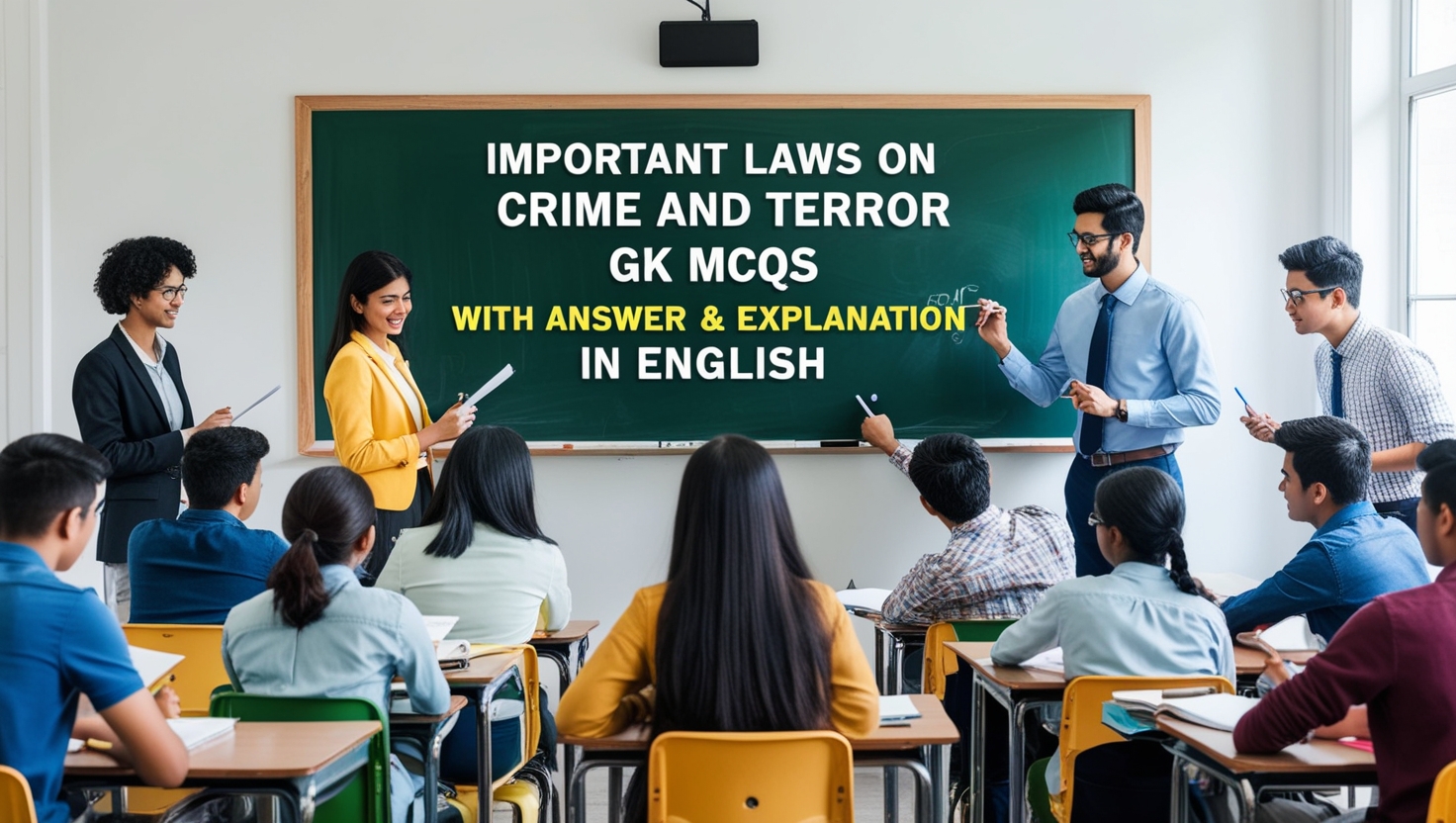
In today’s world, understanding the legal frameworks surrounding crime and terrorism is crucial for both citizens and law enforcement. This article presents a comprehensive set of Important Laws on Crime and Terror GK MCQs With Answer & Explanation in English, designed to enhance your knowledge of the legislative measures in place to combat crime and terrorism.
Each question not only tests your grasp of these laws but also provides detailed explanations to help you grasp their implications and significance. Whether you’re preparing for exams or seeking to broaden your awareness, these MCQs serve as an essential resource.
1. In which year was the Armed Forces Special Powers Act (AFSPA) passed?
- 1956
- 1957
- 1958
- 1959
Show Answer
Answer: 1958
Enacted in 1958, AFSPA grants special powers to the Indian Armed Forces. It allows them to maintain public order in “disturbed areas,” which are regions affected by significant violence or conflict. The act has generated debates over human rights issues due to the broad powers it grants to the military in these areas.
2. An area declared “disturbed” according to the Disturbed Areas (Special Courts) Act, 1976 has to maintain status quo for how many months?
- 2 months
- 3 months
- 4 months
- 6 months
Show Answer
Answer: 3 months
According to this act, once an area is declared ‘disturbed,’ it must maintain the status quo for a minimum of three months. This provision is meant to provide stability and support the authorities in restoring normalcy in such areas.
3. In which year was the Armed Forces Tribunal Act passed?
- 2007
- 2008
- 2009
- 2010
Show Answer
Answer: 2007
The Indian Parliament passed this act in 2007, leading to the establishment of the Armed Forces Tribunal (AFT) in India. The AFT is a specialized tribunal for adjudicating disputes and complaints related to the armed forces, ensuring a separate judicial forum for matters involving military personnel.
4. The Arms Act was enacted by the Parliament of India in which year?
- 1958
- 1959
- 1960
- 1961
Show Answer
Answer: 1959
The Arms Act of 1959 was enacted by the Indian Parliament to consolidate and amend the law relating to arms and ammunition in order to curb illegal weapons and violence stemming from them.
5. The Arms Act of 1959 is divided into how many chapters?
- 4
- 5
- 6
- 7
Show Answer
Answer: 6
The Arms Act of 1959 is divided into 6 chapters. Chapter I: Parliamentary, Chapter II: Acquisition, Possession, Manufacture, Sale, Import, Export, and Transport of Arms and Ammunition, Chapter III: Provisions relating to licences, Chapter IV: Powers and Procedure, Chapter V: Offences and penalties, and Chapter VI: Miscellaneous.
6. The Nirbhaya Act was passed in which year?
- 2013
- 2014
- 2015
- 2016
Show Answer
Answer: 2013
The Nirbhaya Act, passed in 2013, resulted in amendments to the Indian Penal Code, Indian Evidence Act, and Code of Criminal Procedure, 1973. These amendments sought to strengthen the legal framework related to sexual offenses, especially those against women, in response to a high-profile sexual assault case in Delhi in 2012.
7. The Cigarettes and Other Tobacco Products Act, 2003 prohibits smoking of tobacco in which of the following places?
1. Auditoriums
2. Movie theatres
3. Hospitals
4. Public transport
Choose the right option:
- Only 1 & 2
- Only 2 & 3
- Only 1 & 4
- 1, 2, 3 & 4
Show Answer
Answer: 1, 2, 3 & 4
This act, enacted in 2003, prohibits smoking in specified public places, including auditoriums, movie theaters, hospitals, and public transport, to protect people from the harmful effects of tobacco smoke.
8. Which of the following statements are correct with respect to the Cigarettes and Other Tobacco Products (Prohibition of Advertisement and Regulation of Trade and Commerce, Production, Supply and Distribution) Act, 2003?
1. Advertisement of tobacco products including cigarettes is prohibited.
2. Tobacco products cannot be sold to a person below the age of 18 years.
3. A fine up to Rs. 200 can be imposed for smoking in a public place.
Choose the right option:
- Only 1
- Only 2
- Only 1 & 3
- 1, 2 & 3
Show Answer
Answer: 1, 2 & 3
According to the Cigarettes and Other Tobacco Products (Prohibition of Advertisement and Regulation of Trade and Commerce, Production, Supply, and Distribution) Act, 2003, advertisement of tobacco products including cigarettes is prohibited, tobacco products cannot be sold to a person below the age of 18 years, and a fine up to Rs. 200 can be imposed for smoking in a public place.
9. The Sati (Prevention) Act, 1987 is a law enacted by the government of which state?
- Andhra Pradesh
- Rajasthan
- Maharashtra
- Gujarat
Show Answer
Answer: Rajasthan
The Sati (Prevention) Act of 1987 is a law enacted by the Rajasthan government in 1987. It became an Act of the Parliament of India with the enactment of the Commission of Sati (Prevention) Act of 1987 in 1988.
10. In which year was Sati first banned under the Bengal Sati Regulation?
- 1829
- 1830
- 1831
- 1832
Show Answer
Answer: 1829
The Sati (Prevention) Act of 1987 was initially enacted by the Rajasthan government and later became an Act of the Parliament of India with the passage of the Commission of Sati (Prevention) Act of 1987 in 1988. These laws are aimed at preventing and criminalizing the act of sati, where a widow self-immolates or is forced to commit suicide on her husband’s funeral pyre. The legislation is designed to protect women’s rights and prevent such harmful and regressive practices.







